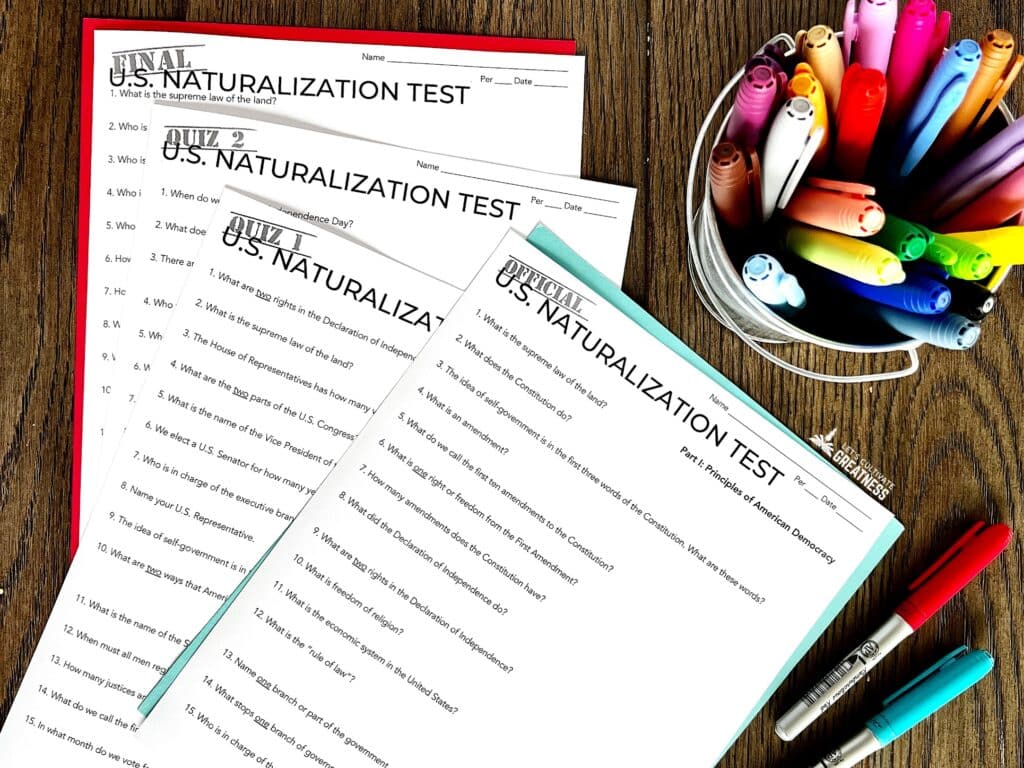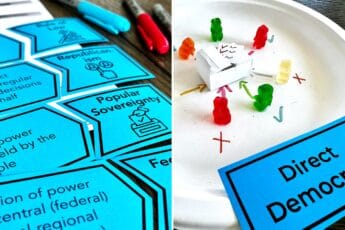Once something because a requirement, it often loses its joy. It seems like that’s precisely what’s happened now that the Citizenship Test is a high school graduation requirement in many states.
During the 2010s, one specific group, the Civics Education Initiative, made it their goal to have all 50 states make passing some form of the US Naturalization Test (the official name of the test) a high school graduation requirement. Now over a dozen do. Full disclosure—my state does not.
I’ve heard many Government and Civics teacher friends in states that do require it talk about it being “one more thing” and “such a joke.” Some say their schools have students do it in 8th and 9th grade so it doesn’t “get in the way” of graduating.
Yikes.
The Citizenship Test is the axis my Civics class rotates around. I couldn’t imagine teaching the course without my 4-part test series set-up, and with the way I’ve structured things, it’s a fun activity change-up to the regular day-to-day unit assignments.
Without feet dragging or stressed-out last-minute millionth retakes, my students —seniors on the verge of voting and graduation—don’t just pass it by the bare minimum, but rather with near-perfect scores. And while it isn’t a requirement in my state, I make it one to pass my class.
I want to share how I do it in my senior Civics class. But first, let’s go over the basics of the US Citizenship Test.
What is the US Citizenship Test?
The US Citizenship and Immigration Services administers the US Naturalization Test, and it’s one of the final things a person seeking to become a naturalized citizen must complete.
It is done in an interview that also verifies proficiency in speaking, reading, and writing in English. The test bank contains 100 questions—about 60 relating to civics and government, 30 covering US history, and ten touching on geography and cultural topics.
The questions are open-ended but only require a short answer. The interviewer asks ten out the 100, and to pass the test, you must get six correct.
Sounds easy enough, right? Yes! It is. The questions are things like “Who is in charge of the executive branch?”, “What are the two parts of the US Congress?” and “What did the Emancipation Proclamation do?”
How Not to Teach the Citizenship Test
Now here’s where the requirement part ruins it. The information has become something for kids to memorize, not know by heart. When we have to memorize something, we do it out of context and without meaning.
To know by heart means to be so familiar with it that we don’t have to think it over. We know it automatically. But that only can happen when we know the why.
Reframing the test and the content of all the questions as the whole point of your Civics class makes all the difference.
One of the easiest, most natural ways to add more inquiry—authentic inquiry—into your Civics class is to start and end with the Citizenship Test. This inherently gives the test its why. It frames your whole course as providing that needed context.
When we’re thick in our Three Branches of Government unit, we reinforce who our current US Senators are and learn why the House of Representatives is based on population. Or when we are in our Voting and Election unit, I share the Founder’s rationale for why Election Day is on a Tuesday in November.
So now, let me give you the step-by-step on making the citizenship test into a meaningful (and fun!) course-long inquiry. At the end, I also include tips for frequent questions I get.
1. Make it a Week 1 Activity
Or your Day 1 activity if you have a regular-length class that day. In my class, after the syllabus and ice breakers, we brainstorm what the central concept for our course—citizen—means, and I pose our course-long overarching essential question: “How can I be an informed and engaged citizen?”
Then, I hand out the test (I use just the 60 civics-related questions) for them to take. Most get fewer than 20 correct.
We debrief, reflecting on why they think they did so badly or what someone credits for why they did so well. We also discuss which questions are fair to include and which are unnecessary. We also brainstorm ones that should be on the test that aren’t.
This leads naturally to the question of what we’ll cover in the class and the essential information a US citizen should know.
2. Promote Science-Based Study Hacks
I tell my students three times throughout the semester that they’ll be tested on these questions—two quizzes, each with half the questions and one final test with all 60 again.
And while we’ll be learning all this information as we progress through our units, they still will need to study for the tests.
So for the next activity, we read an article about brain-science-backed study habits, and they form their study plan. This signals that this is their responsibility as a citizen but that I’m giving them support to succeed.
3. Hold Mid-Term Quizzes
In Week 6 and again in Week 12, I give a quiz with half the questions each. I use some of the questions as bellringers in the week leading up to them and give them daily reminders.
To make it fun, I give small prizes to students who earn 100%. In recent years, vinyl stickers have been a big hit. You can find packs of hundreds on Amazon for less than $10.
I don’t allow retakes on these quizzes because it motivates them to study. Knowing this, most students will get 100% or only miss a couple.
4. Hype the Final Test
Leading up to the final test at the end of the semester, make a big deal out of it. Check that students have their study strategies in place, reminder alerts on their phones to study 10-15 minutes a day, and Test Day marked in their calendar.
5. Celebrate Passing
Simply put, continue the hype that they passed. Talk about how proud you are of your students and how proud they should be of themselves!
I hand out cheesy Certificates of Citizenship when students pass. I use the 60% standard the US Citizenship and Immigration services use. This creates a tangible recognition that a student has (or not yet has) met the benchmark. And, of course, anyone with 100% gets a sticker!
I allow retakes only for students who scored below 60%.
Differentiating the Citizenship Test
Since my grade book is set up to be standards-based, I make this test series its own category so I can still grade it based on points. I weigh the category 10 or 15% of their total grade.
The practice test from Week 1 can be marked for completion if you’d like. I don’t enter it at all since it is now their study guide for upcoming quizzes and final test.
I put the test scores as raw numbers out of 30 or 60. But to “pass” the test and pass the class, the benchmark is 60%—the same as the actual test.
Creating an Authentic Civics PBL
The natural next question after “Can you pass the Citizenship Test?” is “Should you have to in order to graduate high school?”
So, why not have students thoughtfully answer that?
Whether your state or district requires it or not, it’s a great question for them to ponder. It brings in ethical debates on citizenship, civic responsibilities, and the rights of natural-born citizens. It asks students their viewpoints on decisions made by adults who are decades removed from high school. And it has no right answer. This makes it the perfect essential question inquiry to guide a PBL project!
After students take their Final Test, they are prime to make a great personal argument for or against in an op-ed style essay. Since my state doesn’t require passing the test, I encourage students who argue it should be to submit it to our local paper and as a letter to our state legislators.
I also post their essays (since op-ed essays are less than a page!) in the hallway in a Yes / NO style display.
This is the perfect way to end our course.
I have a Citizenship Test Series + Op-Ed Essay PBL Kit available if this sounds like the perfect way to try inquiry- and project-based learning in your Civics class without a huge commitment.

If you want a done-for-you kit to create these same steps in your classroom, grab my Citizenship Test 4-Part Series kit. It contains both a 60-Civics-Questions-Only series and an All-100-Question series. If you want to add in the extension project of an Op-Ed essay, you can get everything in this all-in-one PBL unit kit.
Feature image photo credit: Luke Michael









